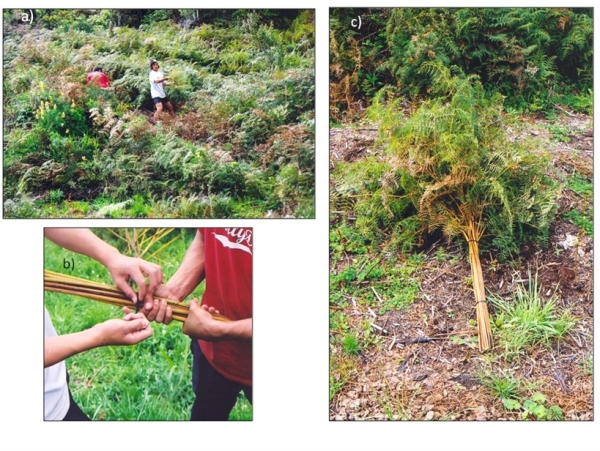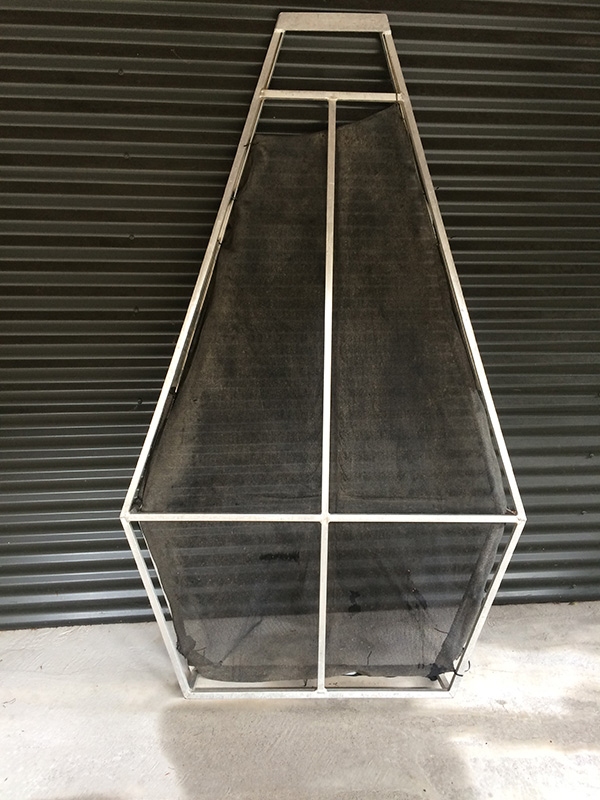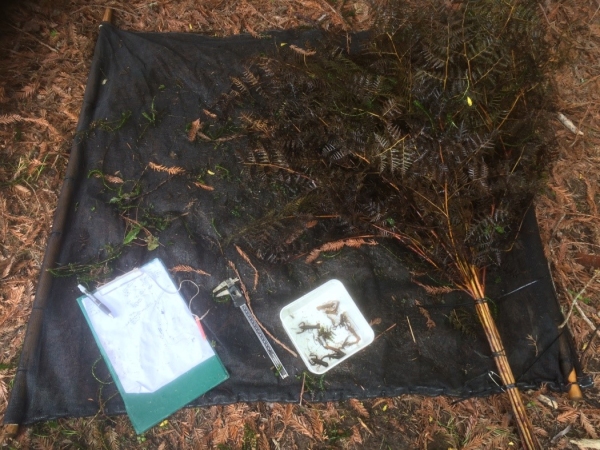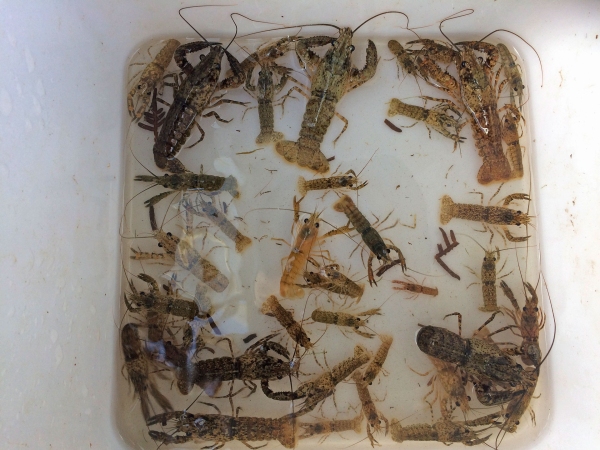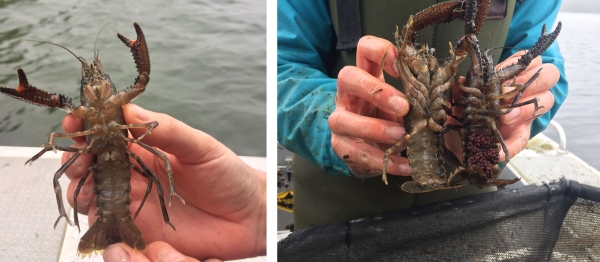Tau kōura is a traditional Māori fishing method commonly used to harvest kōura or freshwater crayfish in areas where they are abundant.
It is commonly used to harvest kōura or freshwater crayfish (Paranephrops planifrons) in the Te Arawa and Taupō lakes, where kōura are abundant.
A variation of tau kōura which makes use of individual fern bundles is also used to harvest kōura and small fish (e.g. elvers and whitebait) in streams, rivers and the shallow shoreline areas of lakes, ponds and wetlands. These fern bundles bundles are known as whakaweku in the Te Arawa and Taupō districts, and as koere and taruke in other areas.
Individual whakaweku can be used as a kōura monitoring tool and, like the tau kōura method, have significant advantages over other monitoring tools in many situations.
They are particularly suitable for use in non-wadeable streams and rivers, and by iwi and community groups who do not have access to specialised electric fishing equipment. Whakaweku catch good numbers of kōura, without the sex and size biases of other sampling methods such as baited traps and nets. Sampling kōura using whakaweku is also inexpensive. (See related publication on tau kōura as a sampling method).
Whakaweku construction
- Collect bracken fern (Pteridium esculentum) fronds by cutting them off near ground level. This leaves the rhizome intact so that the fern regrows quickly.
- Construct bundles of about 10-12 fronds by binding their stems together. Using strong plastic cable ties, adjust the fronds so that they form an open bunch, and cut the ends off the fern bundles to make a “handle” (Fig. 1)
Tau kōura sampling equipment (no boat):
- A kōrapa (a portable kōura landing net)
- Waders
- An ice cream container or two for sorting and holding kōura
- Calipers for measuring kōura size i.e., orbit carapace length (OCL).
- Clipboards, pencils and water-proof paper for data recording
- A bucket for holding sampling equipment and/or kōura.
If you are sampling koura in a lake or large river using a boat, include the following:
You will need a kōrapa to collect the koura, to avoid kōura escaping in response to air exposure. To make a kōrapa (1.2m wide x 2m high) you will need the following materials:
- aluminium frame (a local sheet metal engineering shop should be able to construct this)
- shade cloth (70%)
- cable ties to attach shade cloth to frame.
Make sure the boat you are using for monitoring is fit for the purpose and contains appropriate safety equipment. Life jackets should be worn at all times when working from the boat, as well as appropriate clothing to protect from weather exposure.
Video 1 - retrieving the whakaweku in Te Wairoa Stream [Video credit: M. Katipa]
See publication detailing the use of the tau koura in Lake Rotoiti. [PDF 200KB]
Kōrapa
You will need a kōrapa (a portable kōura landing net) to collect the kōura, as you will be retrieving the whakaweku to avoid kōura escaping in response to air exposure. You can make a simple, robust, kōrapa (1.4m wide x 1.5m high) from the following materials (Fig 2.):
- shade cloth (70%)
- wood poles (e.g., wooden handles used for garden implements)
- chain (bottom line)
- cable ties
- strong cord (top line) (Fig. 2).
When you are sampling large rivers by boat, a traditional kōrapa is more practical.
Where to put your whakaweku
The individual whakaweku should be anchored on the streambed and positioned in line with stream flow. You can use a rope tied to the whakaweku to anchor the whakaweku to the bank or waratah (Fig. 3).
Snap fasteners attached to the whakaweku will make retrieval easier. The whakaweku (once water-logged) is usually kept in position by its own weight in areas of low current velocity. In faster flows, or in deeper water, you may need to add weight (e.g., rocks) to the whakaweku or attach it to a waratah to anchor it in the desired location.
You can set whakaweku anywhere in a stream where the water depth is greater than about 50 cm, including in deep pools, beneath undercut banks or mid-stream. The whakaweku work even if they are not fully submerged in water.
Retrieving your whakaweku sample
Leave the whakaweku to be colonised by kōura for about two weeks before sampling. Then:
- retrieve it by positioning your kōrapa immediately downstream of the whakaweku
- drag the whakaweku into it (Fig. 4)
- lift the kōrapa out of the water and place it on the bank before shaking the kōura out of the whakaweku and into the kōrapa (video 2)
- place the catch from the whakaweku into an ice cream container and process
- note the presence of bycatch such as fish and other macroinvertebrates.
Video 2: Retrieving a whakaweku in Te Wairoa Stream. [Video: M. Kaipa]
Once you have processed the catch, return unwanted kōura and bycatch to the water as soon as you can. If you are using a boat, retrieve the fern bundle as you would in a lake using a traditional tau kōura.
Tau koura sample processing
Measuring population characteristics:
- Measure kōura - the OCL or orbit-carapace length is measured from behind the eye to the end of the carapace (above the tail) along the top and centre of the back.
- Determine sex of kōura, and the presence of eggs/attached juveniles on females.
- Wet weight of kōura can be estimated from the OCL using the following equation from Hicks and Riordan (unpublished data; Riordan 2000): Wet weight = 0.000648 OCL3.0743
How do you tell males and females apart? The following images show the location of male gonads and a young female (small size) carrying eggs that are at an early stage of egg development.
Record harvested catch: If part of the catch is taken for consumption following local protocols, measure volume and weight of the total catch harvested and state the harvesting size range criteria (e.g., range of sizes taken if large ones are returned). We suggest that existing Te Arawa protocols are encouraged such as the release of egg-bearing females and small koura e.g. >30 mm OCL so that koura have bred at least once before harvesting. [See Sustainable management of freshwater crayfish paper]. In addition, consideration should be given to releasing the largest individuals in the population since these are the most successful ones and are the biggest contributors to reproduction.
Return and care for the sampled kōura: Returning the non-harvested catch to the lake in batches along the 100 m collection area. Note that during the processing it is important to minimise the stress on the kōura by minimising handling and keeping them covered and in the shade.
References
Ian A. Kusabs, Brendan J. Hicks, John M. Quinn, William L. Perry & Hēmi Whaanga (2018) Evaluation of a traditional Māori harvesting method for sampling kōura (freshwater crayfish, Paranephrops planifrons) and toi toi (bully, Gobiomorphus spp.) populations in two New Zealand streams, New Zealand Journal of Marine and Freshwater Research, DOI: 10.1080/00288330.2018.1481437
Ian A. Kusabs, Brendan J. Hicks, John M.Quinn, David P. Hamilton (2015). Sustainable management of freshwater crayfish (kōura, Paranephrops planifrons) in Te Arawa (Rotorua) lakes, North Island, New Zealand. Fisheries Research Vol 168, pp 35-46. DOI:10.1016/j.fishres.2015.03.015
Acknowledgements
The content on this page is based on research by Ian Kusabs (Fisheries Consultant, Ngati Tuwharetoa, Te Arawa), Willie Emery (Kaumatua, Ngati Pikiao and Te Arawa Lakes Trust, Rotoiti) and John Quinn (NIWA).

